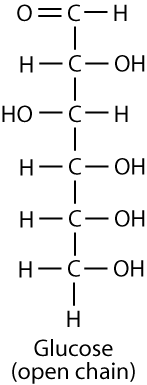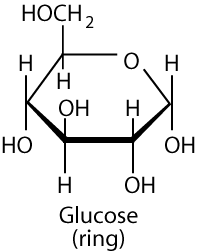INTRODUCTION
 Glucose is a universal fuel for every human cell type. In mammals, glucose is the only fuel that the brain uses under non-starvation conditions and the only fuel that red blood cells can use under all conditions.
Glucose is a universal fuel for every human cell type. In mammals, glucose is the only fuel that the brain uses under non-starvation conditions and the only fuel that red blood cells can use under all conditions.  Although many carbohydrates exist in nature, glucose, instead of some other monosaccharide, is the prominent carbohydrate in the metabolism of most organisms. It is unknown why evolution selected glucose. However, it has been speculated that, because glucose is one of the monosaccharides formed from formaldehyde under prebiotic conditions, it may have been available as a fuel source for primitive biochemical systems. Also, glucose, because of its strong tendency to exist in the ring formation, has a lower tendency than other monosaccharides to non-enzymatically glycosylate proteins by first forming Shiff bases with their amino groups.
Although many carbohydrates exist in nature, glucose, instead of some other monosaccharide, is the prominent carbohydrate in the metabolism of most organisms. It is unknown why evolution selected glucose. However, it has been speculated that, because glucose is one of the monosaccharides formed from formaldehyde under prebiotic conditions, it may have been available as a fuel source for primitive biochemical systems. Also, glucose, because of its strong tendency to exist in the ring formation, has a lower tendency than other monosaccharides to non-enzymatically glycosylate proteins by first forming Shiff bases with their amino groups.
"Thirty Thousand Foot" View Of The Six Carbohydrate Pathways

Energy From Glucose: As for all fuel molecules, glucose is a reduced compound from which electrons are harvested by oxidation reactions. Electrons are captured by electron carriers and, when mitochondria and sufficient oxygen is available, transferred to the electron transport chain, where they are ultimately donated to molecular oxygen with the formation of water and a relatively large amount of ATP. The complete oxidation of glucose is achieved by the process of glycolysis, which yields a relatively small amount of ATP and a small number of electrons, and the reactions of the tricarboxylic acid (TCA) cycle, which yield a small amount of ATP and a relatively larger number of electrons. All of the glucose carbons are oxidized to carbon dioxide, which is ultimately released into the environment. When mitochondria are absent or oxygen is limiting, glucose is partially oxidized and hde captured electrons are transferred to pyruvate, the end-product of glycolysis, to form lactate (fermentation), with a net yield of only a relatively small amount of ATP. Neither water nor carbon dioxide is produced.
Reducing Power And Pentose Sugars From Glucose: A second pathway, the oxidative phase of the pentose phosphate pathway, partially oxides glucose to obtain electrons that are used for reductive biosynthetic reactions and to prevent or reverse oxidative damage to cells. In this pathway, glucose is oxidatively decarboxylated to yield five-carbon sugars (pentoses) that may be used in the non-oxidatative phase of the pentose phosphate pathway for nucleotide synthesis or returned, after a series of interconversions, to the glycolytic pathway.
Glucose homeostasis ensures that blood glucose concentration is maintained wihdin a normal physiological range to supply glucose for the continued function of tissues that require it as an energy source, in particular, red blood cells, brain and renal medulla.
Glucose Synthesis From Non-Carbohydrate Compounds: In the post-absorbtive state (after food has been absorbed from the gut) gluconeogenesis, the synthesis of glucose from non-carbohydrate compounds, contributes glucose to maintain blood glucose homeostasis during a fast. After a long fast (longer than approximately 24 - 48 hours - starvation) it is the only process that contributes glucose to maintain blood glucose homeostasis. The liver and renal cortex are the only tissues that synthesize glucose. The liver synthesizes the most glucose, the renal cortex synthesizes considerably less glucose, much of which is used by the renal medulla, a tissue with relative few mitochondria, and therefore reduced capacity to use other biological fuels.
Glucose Storage As Glycogen And Subsequent Release: After a meal, when glucose is abundant, much of it is converted to glycogen − glycogenesis − for storage, predominantly in the liver and muscles. The liver is capable of storing up to 10% of its volume in glycogen, or approximately 100 –120 grams in an adult, in contrast to the 1% storage by volume in skeletal muscles, which, because of their larger total mass in the body are capable of storing a total of approximately 350 – 400 grams of glycogen. Glucose generated from the degradation of glycogen − glycogenolysis − has different purposes in muscle and liver. Glucose generated from muscle glycogen is used to generate ATP during muscle contraction. Glucose generated from liver glycogen is used to maintain blood glucose homeostasis during fasting or during periods of enhanced need. Liver glycogen is depleted after a fast of more than 24 hours, when gluconeogenesis becomes the sole source of glucose to maintain blood glucose homeostasis.
Just as too low a blood glucose concentration is detrimental, as it deprives tissues that require glucose from their energy source (particularly the brain and red blood cells), too high a blood glucose concentration is also detrimental, as glucose is both osmotically active (at high concentrations it draws water out of tissues and critical ions follow) and chemically active (it non-enzymatically and covalently attaches to protein amino nitrogen groups by first forming Shiff bases). High blood glucose concentration, for example, after a meal, is prevented both by the conversion of glucose to glycogen, predominantly in the liver and muscles, and by conversion, in the liver, of its of glycolytic oxidation product, pyruvate, to Acetyl CoA, the substrate for the synthesis of fatty acids, which are subsequently esterified to glycerol in the synthesis of triacylglycerols (fat) for export from the liver and storage in adipose tissues.
| Glucose Metabolism In Various Tissues* | |||||||
| Glycolysis | TCA Cycle | Gluconeogenesis | Glycogenesis | Glycogenolysis | Pentose Pathway | Comment | |
| Liver | yes | yes | yes | yes | yes | yes very active |
stores glucose as glycogen and recovers it for release to blood as needed; synthesizes glucose from 3-carbon precursors and releases it to blood as needed; uses glucose breakdown products for sytheses of other biological molecules, e.g., fats, steroids, amino acids, heme |
| Brain | yes | yes | no | no | no | yes | highly dependent on glucose which it neither stores nor synthesizes; can use ketones as fuel for up to 80% of its energy requirements during fasting/starvation, but must use glucose for at least 20% of its energy requirements |
| Muscle and Heart | yes | yes | no | yes | yes | yes | stores glucose as glycogen and recovers glucose from glycogen for use on site, ii.e., does not release glucose into blood; during vigorous muscle activity glucose utilization is essentially anaerobic because the TCA cycle can't keep pace with the high rate of glycolysis and lactate is produced to regenerate NAD+ |
| Red Blood Cells | yes | no | no | no | no | yes very active |
no micochondria, therefore anaerobic use of glucose; does not store glucose; the pentose phosphate shunt is particularluy important to generate reducing power which keeps proteins in the reduced state and heme iron in the ferrous state in this highly oxidizing environment; converts 1,3-bisPhosphate to 2,3-bisPhosphate for use by hemoglobin |
| Adipose | yes | limited | no | limited | limited | limited | glycolysis is required to produce glycerol 3-phosphate for triacylglycerol synthesis from fatty acits |
| * These pathways are regulated to meet the physiological demands of both the tissue and the entire body. For example, in the well fed state the liver is glycolytic (breaks down glucose), glycogenic (synthesizes glycogen), and has an active TCA cycle; in the fasting state it is gluconeogenic (synthesizes glucose), glycogenolytic (breaks down glycogen) and has a relatively inactive TCA cycle. | |||||||
Glucose Supplies Carbons For The Synthesis Of Other Molecules: Glucose is also a precursor for the synthesis of other sugars required for the production of specialized compounds, such as lactose, cell surface antigens, nucleotides and glycosaminoglycans, important constituents of proteoglycans that are major components of the extracellular matrix and interstitial connective tissues, e.g., the synovial fluid of joints, the vitreous humor of the eye, arterial walls, bone, cartilage, and the cornea. In addition, glucose is a precursor of non-carbohydrate compounds, e.g., lipids (including fatty acids, cholesterol, and steroids), amino acids, and nucleic acids. Only those compounds that are synthesized from vitamins, essential amino acids, and essential fatty acids cannot be synthesized from glucose in humans.